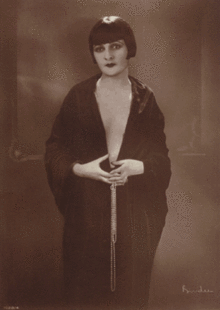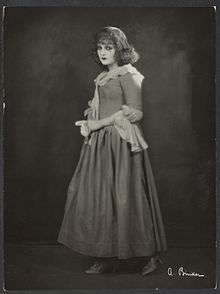Lya De Putti
| Lya de Putti | |
|---|---|
 | |
| Born |
Amalia Putti January 10, 1897 Vécse, Austria-Hungary, (today Vojčice, Slovakia) |
| Died |
November 27, 1931 (aged 34) New York City, New York, U.S. |
| Occupation | Actress |
| Years active | 1918–1929 |
| Spouse(s) | Zoltán Szepessy (1913-1918) |

Lya de Putti (January 10, 1897 – November 27, 1931) was a Hungarian film actress of the silent era, noted for her portrayal of vamp characters.
Early life and career
Born as Amália Putti[1] (Hungarian: Putti Amália) in Vécse, Austria-Hungary (today Vojčice, Slovakia), she was one of the four children of Gyula Putti (Hungarian: Putti Gyula), a cavalry officer,[2] and his wife, the former Mária Holyos[3] (Hungarian: Holyos Mária). She had two brothers, Géza and Sándor, the latter served as a first lieutenant in the Austro-Hungarian army,[3] and a sister, Mária.
She began her stage career on the Hungarian Vaudeville circuit. She soon progressed to Berlin, where after performing in the ballet, she made her screen debut in 1918. She became the premiere danseuse at the Berlin Winter Garden in 1924.
Around that time German film director Joe May noticed her and cast her in her first important film, The Mistress of the World (1919). She followed this success with noteworthy performances in Manon Lescaut and Varieté (1925). The latter featured her opposite Emil Jannings and directed by E. A. Dupont. Both films are UFA productions. While in Germany, de Putti starred with such actors as Conrad Veidt, Alfred Abel, Werner Krauss, Grete Mosheim, and Lil Dagover and was filmed by directors F. W. Murnau and Fritz Lang.
De Putti came to America in February 1926. At the time she told reporters she was twenty-two years old but her ocean liner's records list her as having been twenty-six. De Putti was generally cast as a vamp character, and often wore her dark hair short, in a style similar to that of Louise Brooks or Colleen Moore. De Putti starred in D. W. Griffith's The Sorrows of Satan (1926). The film was released in two versions, one in America and the other in Europe. In the American version one scene had de Putti fully dressed whereas the same scene in the European release had de Putti topless.
Private life
De Putti was once rumored to be engaged to Count Ludwig von Salm-Hoogstraeten, a former husband of the American oil heiress Millicent Rogers. She denied the engagement. In 1913, she married Zoltán Szepessy, a county magistrate. They divorced in 1918. The couple had two daughters, Ilona (b. 1914) and Judith (b. 1916).
Return to Broadway
The following year, de Putti went to Hollywood but found little success there, inhibited by her foreign accent. Despite working with such distinguished actors as Adolphe Menjou and Zasu Pitts, she failed to make it big and left the screen by 1929 to attempt to restart her career on Broadway.
Later she went to England to make silent movies and studied the English language. She then returned to America to attempt talkies.
Hospitalized to have a chicken bone removed from her throat, de Putti contracted a throat infection. She was taken to the Harbor Sanitarium, then located at 667 Madison Avenue where she reportedly behaved irrationally and eluded her nurses. Eventually she was found in a corridor. She developed pleurisy in her right side, followed by pneumonia in both lungs.
Death
She died in 1931, aged 34, at the Harbor Sanitorium, leaving just £800 (UK equivalent at the time) and a few bits of jewellery. Four years earlier, £800 was her weekly wage. She is interred in the Ferncliff Cemetery in Hartsdale, New York.
Lya De Putti in popular culture
- De Putti appears on the cover of Jessamine (band)'s 1995 self-titled.Jessamine (CD insert). Jessamine (band). Kranky. 1995. Kranky003.
- In the film Cabaret (1972) singer Sally Bowles (Liza Minnelli) tells a friend that Lya de Putti is her "favorite screen siren". In a subsequent scene, Bowles dismisses de Putti, claiming that she "makes too many faces."
Filmography
Features:
- The Emperor's Soldiers (1918)
- On the Waves of Happiness (1920)
- Gypsy Blood (1920)
- You Are the Life (1921)
- The Indian Tomb (1921)
- The Love Affairs of Hector Dalmore (1921)
- Driving Force (1921)
- Ilona (1921)
- Othello (1922)
- The Burning Soil (1922)
- Phantom (1922)
- The Three Marys and Mr. Marana (1923)
- The Ravine of Death (1923)
- Die Fledermaus (1923)
- The Island of Tears (1923)
- Thamar, The Child of the Mountains (1924)
- Malva (1924)
- Claire (1924)
- In the Name of the Kaisers (1925)
- Comedians (1925)
- Varieté (1925)
- Jealousy (1925)
- Manon Lescaut (1926)
- Young Blood (1926)
- The Sorrows of Satan (1926)
- Prince of Tempters (1926)
- God Gave Me Twenty Cents (1926)
- The Heart Thief (1927)
- Buck Privates (1928)
- Midnight Rose (1928)
- Charlott Verloh (1928)
- The Scarlet Lady (1928)
- All About Love (1929)
- The Informer (1929)
Short Subjects
- A Christmas Movie for Adults (1924)
Documentaries
- Cinema Europe: The Other Hollywood (1995)
- The Love Goddesses (1965)
- Herrliche Zeiten (Wonderful Times) (1950)
References
- Herzog, Peter and Roman Tozzi. Lya de Putti: Living Life and Not Fearing Death. Corvin: 1993.
- Los Angeles Times. "Film Star Succumbs." November 27, 1931, Page 1.
- New York Times. "Lya de Putti Dead Here of Pneumonia." November 27, 1931, Page 20.
- ↑ Kőniger, Miklós (October 1996). "Egy elfeledett sztár" [A forgotten star]. filmvilag.hu (in Hungarian). Budapest, Hungary: Filmvilág Alapítvány. pp. 13–14. Retrieved 24 September 2012.
- ↑ Schöpflin Aladár (2010) [1929-1931]. B. Kádár Zsuzsanna, ed. Magyar Színművészeti Lexikon [Hungarian Actors Encyclopedia] (in Hungarian). Vienna, Austria-Hungary: Wesley Egyház- és Vallásszociológiai Kutatóközpont. p. 503. ISBN 1161272968. Retrieved 24 September 2012.
- 1 2 "Pesky-Rosenzweig" (PDF). militaria.hu (in Hungarian). Budapest, Hungary: Hadtörténeti Intézet és Múzeum. 20 January 2011. Retrieved 24 September 2012.
External links
- Lya De Putti at the Internet Movie Database
- Lya de Putti Photo Gallery at silent-movies.org
- Photographs of Lya de Putti
- Lya de Putti at FindAGrave